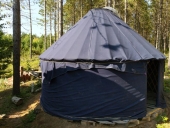I've been grinding away at completing
a yurt for the last year. If you look at that thread, to the end you can see I am nearing the completion of the wood-and-canvas outer structure. I have a number of more elaborate ideas of how to build a RMH to make the interior super cool (er, toasty), but don't have enough moons left in the year to experiment. I'm looking for the most sure fire way to make a comfortable environment in the yurt while sticking with Wheaton Labs standards. Navigating the gray areas within those standards will depend on my daily disposition.
Materials:
8" Portable RMH core made with Uncle Mud at this year's PTJ, with 5 minute riser of superwool inside 10" duct
A few pallets of oversized clay chimney bricks
A packet of ceramic floor tiles
2 slightly rusted 55 gal oil drums
endless supply of heavy duty shipping pallets (most common are 39.5x71" and 40x74")
2 8" duct elbows
4 24x8" duct straights
70x8" duct straight
lots of 6" ducting- 12 elbows, 3 long straights, half dozen short straights, 2 Ts
Roof flashing that says 6" on it but has a much larger hole
tempered glass from a shower door
some rolls of metal screening
3x15' sheets from and old tin roof
a few shorter sections from a newer, corrugated metal roof
a grab bag of lumber
I'm thinking of doing a thermal break and flood mitigation by making a platform with the pallets. The yurt walls should have ~6" excess material at the bottom to create an outer air seal if the pallets are trimmed to match the footprint. I would put some hardware cloth down to exclude rodents if it would be enough to do the perimeter and not the entire footprint.
I'd like to do a pebble style box for the ducting off of the RMH core. I would do a bed/couch platform next to the core, with any extra ducts beyond that built so the top of them would be close to the level of the pallets on the floor to preserve more room in the yurt. The chimney would be vented through the top ring, with glass cut from the shower door covering the rest of the hole. I'd like the chimney as close to the barrel as possible to help with cold starts/rockety-ness.
I figure a ring (hexagon or octagon) of ducting would be the best to distribute a mass of heat around, but would probably complicate construction for the box and the platform too much at this stage, so I'm resigned to some sort of square construction that will fit with the pallets with minimal cutting. I'll have to purchase more 8" ducting, along with the pebble fill, at the least.
I'm currently going through the dozens and dozens of "my stuff"s in my account here to see what covers elements of this build. I'm currently working through the threads on the tipi and Mud's shippable core assemblies (most have focused on the cottage heater that I've found), and Paul's video on the pebble style. I have the Ianto and Wissners books for reference, as well as e-manuscript of Paul and Chris's book. Too many materials to cover it all, so looking for references to specific helpful parts.
The ground of my site has about 6-8" of soil, then it is almost pure sand with a few rocks thrown in under that. I know Paul declared sand to be too insulative for a pebble-style box, but Ernie/Erica have it listed right after cob on their list of conducting materials. When prepping the site, will it make any difference if I simply do a zero cut/fill to level it off, versus digging out all of the soil and working on top of the sand, versus bringing in some lava rock to create a thermal barrier under the pallets with that? I'm setting the bits that resemble sod off to the side, would they be good for anything here? I'm not worried about the pallets rotting, this will likely be moved or redesigned in the next couple of years.









